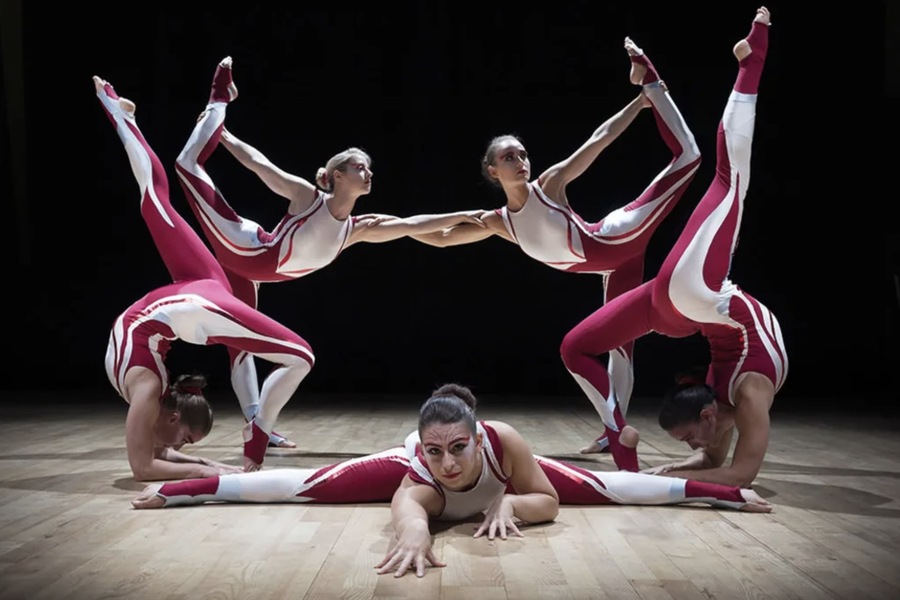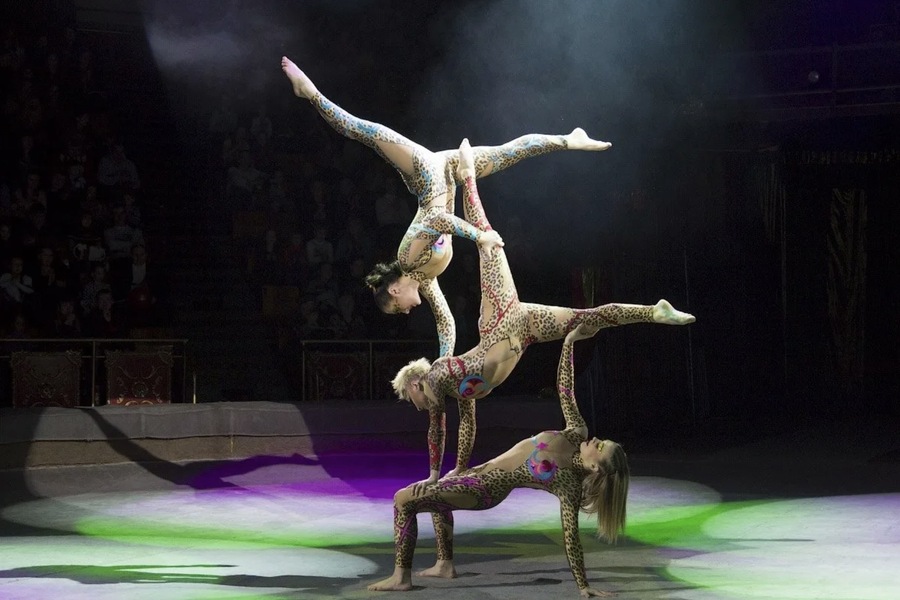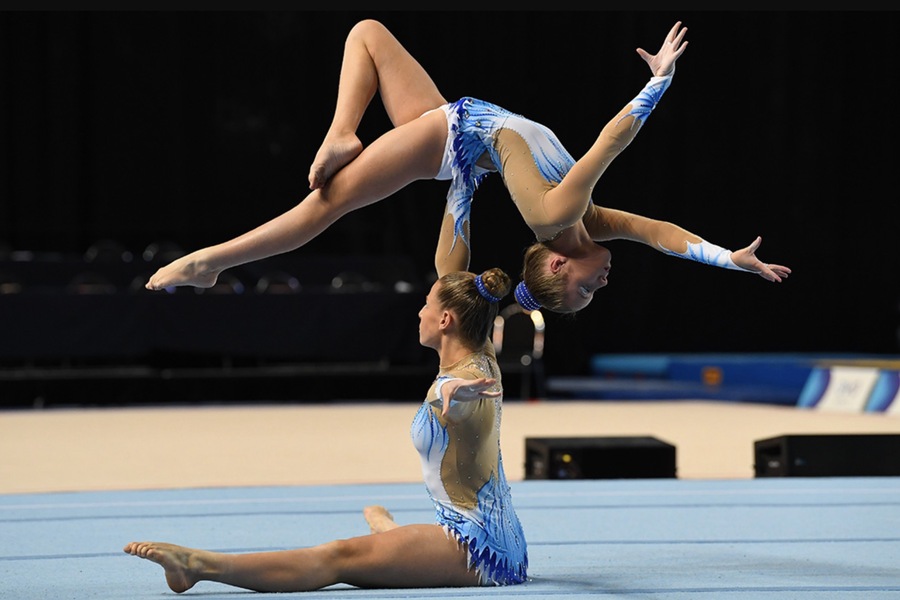Acrobatics, the art of performing extraordinary physical feats, has fascinated and entertained humanity for centuries. From ancient civilizations to modern-day fitness routines, acrobatics has evolved significantly, offering a blend of performance art and physical exercise. Today, adult acrobatics has surged in popularity, becoming a modern fitness trend embraced by enthusiasts worldwide.
Types of Acrobatics
Acrobatics encompasses a wide range of disciplines, each with unique characteristics and challenges. These diverse practices cater to different skill levels and interests, making acrobatics accessible to a broad audience. Here are the main types of acrobatics, detailed and described:
Traditional Forms of Acrobatics
Floor Acrobatics
- Description: Involves performing dynamic and static movements on the ground, such as rolls, flips, and somersaults.
- Characteristics: Requires strength, agility, and coordination.
- Challenges: Precision and timing are crucial to execute movements safely and effectively.
- Benefits: Enhances core strength, flexibility, and cardiovascular fitness.
Hand Balancing
- Description: Focuses on performing balance-based skills using hands and arms to support the body.
- Characteristics: Involves static holds and transitions between different positions.
- Challenges: Requires significant upper body strength, wrist flexibility, and balance.
- Benefits: Improves upper body and core strength, balance, and stability.
Contortion
- Description: The art of extreme flexibility, involving bending and twisting the body into unusual and often aesthetically pleasing shapes.
- Characteristics: Emphasizes flexibility and control over the body.
- Challenges: Demands extensive flexibility and muscular control to perform safely.
- Benefits: Increases flexibility, joint health, and muscular endurance.

Modern Variations of Acrobatics
Aerial Silks
- Description: Involves performing acrobatic maneuvers while suspended from a special fabric.
- Characteristics: Combines climbing, wrapping, and posing in the air.
- Challenges: Requires upper body strength, grip strength, and spatial awareness.
- Benefits: Enhances upper body and core strength, flexibility, and creativity.
Trapeze
- Description: Performing acrobatic movements on a horizontal bar suspended by ropes.
- Characteristics: Can be static or swinging, with solo or partner routines.
- Challenges: Needs strength, timing, and coordination to perform aerial tricks.
- Benefits: Boosts upper body strength, coordination, and aerial awareness.
Acro-Yoga
- Description: A blend of acrobatics and yoga, focusing on partner-based poses and movements.
- Characteristics: Involves a base, flyer, and sometimes a spotter to perform balancing and lifting sequences.
- Challenges: Requires communication, trust, and coordination between partners.
- Benefits: Enhances core strength, flexibility, trust, and teamwork.
Aerial Hoop (Lyra)
- Description: Performing acrobatic poses and movements on a circular steel apparatus suspended in the air.
- Characteristics: Involves spins, holds, and transitions within and around the hoop.
- Challenges: Requires upper body strength, flexibility, and spatial awareness.
- Benefits: Improves upper body strength, flexibility, and artistic expression.
Acrobatic Gymnastics
- Description: A competitive sport that combines elements of acrobatics and gymnastics, performed in pairs or groups.
- Characteristics: Includes dynamic and static routines featuring balance, tumbling, and dance.
- Challenges: Demands coordination, strength, flexibility, and precise timing.
- Benefits: Enhances overall fitness, teamwork, and performance skills.
Partner Acrobatics
- Description: Involves two or more people working together to perform lifts, balances, and dynamic movements.
- Characteristics: Emphasizes strength, trust, and coordination between partners.
- Challenges: Requires communication, precise timing, and shared strength.
- Benefits: Builds teamwork, trust, core strength, and balance.
Cyr Wheel
- Description: Performing acrobatic movements while spinning inside a large, metal wheel.
- Characteristics: Combines balance, strength, and fluid motion.
- Challenges: Requires coordination, balance, and spatial awareness.
- Benefits: Enhances core strength, balance, and overall body control.
Popularity of Adult Acrobatics in Modern Fitness
In recent years, adult acrobatics has gained traction as a dynamic and engaging fitness option. Unlike conventional gym workouts, acrobatics offers a holistic approach to physical fitness, combining strength, flexibility, coordination, and balance. The allure of mastering impressive skills while achieving a full-body workout has attracted fitness enthusiasts of all ages.
Rising Trend in Dubai
Dubai, known for its innovative and luxurious lifestyle offerings, has embraced adult acrobatics as a burgeoning fitness trend. The city boasts state-of-the-art facilities and experienced trainers, making it a hub for acrobatic training in the region. As the trend grows, more residents and tourists are exploring acrobatic classes and workshops, contributing to the fitness culture in Dubai.
The rise of adult acrobatics in Dubai reflects broader trends in the UAE’s fitness and wellness market. The demand for diverse and engaging fitness options is driving the growth of specialized studios and training programs. This trend aligns with the UAE’s commitment to promoting a healthy lifestyle among its residents, supporting the country’s long-term vision for a vibrant and active society.
Historical Background
Ancient Origins of Acrobatics
Acrobatics has ancient roots, with evidence of its practice dating back to early civilizations such as Ancient Egypt, China, and Greece. In these cultures, acrobatics was often performed during religious ceremonies and public festivities. Egyptian tomb paintings depict acrobats engaging in complex balancing acts, while Chinese acrobats entertain royalty with their agility and strength.
Traditional Forms and Purposes
Historically, acrobatics served various purposes, from entertainment to spiritual rituals. In ancient Greece, acrobatic feats were integrated into athletic competitions, while in China, acrobatics was an integral part of traditional festivals and celebrations. These early forms laid the foundation for the diverse and sophisticated acrobatic practices we see today.
First-Ever Acrobatic School
The formalization of acrobatic training can be traced back to ancient China, where the first-known acrobatic school was established during the Han Dynasty (206 BCE – 220 CE). This institution set the stage for systematic training and the development of acrobatic techniques, influencing the evolution of the art form over the centuries.
Evolution Through the Ages
Acrobatics in Medieval and Renaissance Europe
During the medieval and Renaissance periods, acrobatics continued to thrive in Europe. Traveling performers, known as troubadours and jesters, entertained audiences with acrobatic displays at fairs and festivals. This era saw the incorporation of acrobatics into theatrical performances, enhancing the spectacle and entertainment value.
Influence of Circuses and Traveling Performers in the 19th Century
The 19th century marked a significant turning point for acrobatics with the rise of circuses and traveling shows. Pioneering figures like Philip Astley, considered the father of the modern circus, introduced acrobatic acts as a central attraction. The establishment of permanent circus venues and the global tour of circus troupes popularized acrobatics, making it a beloved form of entertainment worldwide.
Role of Acrobatics in Early 20th-Century Vaudeville and Entertainment
In the early 20th century, vaudeville theaters in North America showcased acrobatic acts alongside comedy, music, and dance performances. Vaudeville provided a platform for acrobats to reach a broader audience and contributed to the professionalization of the art form. The advent of cinema and television further extended the reach of acrobatic performances, embedding them in popular culture.
Modern Acrobatics
Influence of Contemporary Circus Companies Like Cirque du Soleil
The modern era of acrobatics has been profoundly influenced by contemporary circus companies, most notably Cirque du Soleil. Founded in 1984, Cirque du Soleil revolutionized circus arts by blending acrobatics with theatrical storytelling, music, and innovative stage design. The company’s success has inspired a resurgence of interest in acrobatics as both an art form and a fitness pursuit.
Development of Competitive Acrobatics
The development of competitive acrobatics, including gymnastics and acrobatic gymnastics, has further elevated the discipline. Gymnastics, an Olympic sport since 1896, showcases acrobatic skills on apparatus such as the balance beam, rings, and uneven bars. Acrobatic gymnastics, recognized by the International Federation of Gymnastics, combines partner work and group routines, highlighting the collaborative aspect of acrobatics.
Integration into Fitness
The integration of acrobatics into modern fitness routines has given rise to innovative practices such as aerial silks, trapeze, and acro-yoga. These activities offer unique physical challenges and benefits, attracting a diverse range of participants.
The popularity of Aerial Silks, Trapeze, and Acro-Yoga
Aerial silks and trapeze involve performing acrobatic movements while suspended from fabric or a bar, enhancing upper body strength and flexibility. Acro-yoga, a blend of acrobatics and yoga, emphasizes trust and communication between partners, promoting both physical and mental well-being. These practices have gained popularity in fitness communities for their combination of strength training, flexibility, and artistic expression.
Benefits of Acrobatic Exercises for Adults
Acrobatic exercises offer numerous benefits for adults, including improved cardiovascular health, increased muscle tone, enhanced coordination, and greater mental focus. The dynamic nature of acrobatic training also makes it an enjoyable and engaging way to stay fit, reducing the monotony often associated with traditional workouts.

Adult Training Programs
Different Types of Adult Acrobatic Training Programs
Adult acrobatic training programs vary widely, catering to different skill levels and interests. Beginner classes typically focus on foundational skills such as balance and coordination, while advanced programs introduce more complex techniques and routines. Specialized classes in aerial silks, trapeze, and acro-yoga offer targeted training for those interested in specific disciplines.
Key Elements of Acrobatic Training
Effective acrobatic training programs emphasize several key elements, including strength, flexibility, balance, and coordination. Core conditioning exercises are crucial for developing the stability and control needed for acrobatic movements. Additionally, flexibility training helps prevent injuries and enhances the range of motion, while balance exercises improve overall body control and spatial awareness.
Health and Safety Considerations
Importance of Proper Training and Supervision
Proper training and supervision are essential for ensuring the safety and effectiveness of acrobatic exercises. Certified instructors provide guidance on correct techniques, helping participants avoid common mistakes and injuries. Supervised training also ensures that participants progress at a safe and manageable pace, reducing the risk of overexertion and strain.
Common Injuries and How to Prevent Them
Common injuries in acrobatics include strains, sprains, and joint dislocations, often resulting from improper technique or inadequate warm-up. Preventive measures include thorough warm-up routines, gradual progression of difficulty, and the use of supportive equipment such as mats and harnesses. Strength and flexibility training also play a crucial role in injury prevention, as they prepare the body for the demands of acrobatic movements. According to guidelines from the UAE Ministry of Health and Prevention, these preventive strategies are essential for maintaining the health and safety of individuals engaging in acrobatic activities.
Safety Gear and Equipment
Safety gear and equipment are vital components of acrobatic training. Mats and crash pads provide cushioning during falls, reducing the impact and preventing injuries. For aerial disciplines, harnesses and safety lines offer additional protection, ensuring that participants can practice complex movements with confidence. Regular equipment maintenance and safety checks are also essential to prevent accidents and ensure a safe training environment.
Cultural Impact
Influence on Other Forms of Art and Performance
Acrobatics has had a significant influence on other forms of art and performance, inspiring innovative approaches to theater, dance, and visual arts. The integration of acrobatic elements into contemporary dance and performance art has expanded the creative possibilities for artists, resulting in captivating and visually stunning productions.
Presence in Popular Media and Entertainment
Acrobatics has a prominent presence in popular media and entertainment, from blockbuster films to television shows and live performances. Iconic movies such as “Crouching Tiger, Hidden Dragon” and “The Matrix” feature acrobatic stunts and choreography, captivating audiences with their visual spectacle. Additionally, talent shows like “America’s Got Talent” showcase acrobatic performers, bringing the art form to mainstream attention.
Social and Community Aspects of Acrobatic Groups and Classes
Acrobatic groups and classes foster a strong sense of community and camaraderie among participants. The collaborative nature of acrobatics, particularly in partner and group routines, promotes teamwork and trust. This social aspect enhances the overall experience, making acrobatic training not only a physical pursuit but also a source of social connection and support.
Conclusion
The evolution of adult acrobatics from an ancient art form to a modern fitness trend reflects its enduring appeal and versatility. With its rich historical roots, diverse practices, and numerous physical and mental benefits, acrobatics continues to captivate and inspire. The rising trend of adult acrobatics in Dubai and its impact on the UAE’s fitness market highlights the growing demand for innovative and engaging fitness options. As more people discover the joy and benefits of acrobatic training, this ancient art form is poised to remain a dynamic and influential part of the modern fitness landscape.



